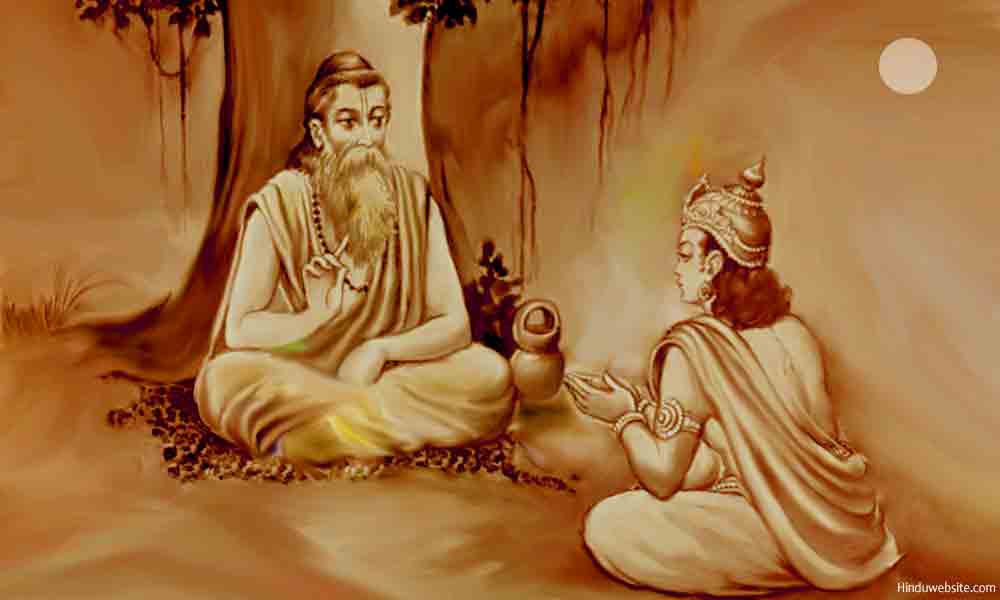
Ashtavakra Samhita, Chapter 1, Verse 19

Contents
Index, Verse 1, Verse 2, Verse 3, Verse 4, Verse 5, Verse 6, Verse 7, Verse 8, Verse 9, Verse 10, Verse 11, Verse 12, Verse 13, Verse 14, Verse 15, Verse 16, Verse 17, Verse 18, Verse 19, Verse 20
Verse 19
yathaivaadarsha madhyasthe
ruupeanthah parithasthu sah
thathaivaasmin shareere antha parithah parameshwarah
Translation
Just as the image that appears in a mirror seems to take hold of it, so does the supreme Lord appears in this body as if he has taken hold of it.
Meaning
The illusion of the Individual Self
This presents an analogy regarding the relation between Brahman and his creation which is very typical to the school of nondualism (advaitha), according to which only the Supreme Self, or Brahman, is real and everything else is a mere projection, or illusion. Here, the Self is the person, or the object that stands before the mirror. The mirror itself is the body or the field of Nature. The image that appears in the mirror is the reflection of the Self or the being. Just as the reflection is unreal, so is the individual or the person. The Self seems to be in the body, but he is not truly present there. What you feel or experience as a being is just a projection. The analogy suggests further that although the Self is present in the body he is not touched by it.
The idea is very much similar to the view held by the Buddhist regarding the non-existence of the Self. According to the Advaita the individual Self is a mere illusion. The body contains a Self that is not of the being and has no individuality. It is the same universal Self which is present in all. In other words, Advaita also holds the view that the body has no Self of its own. It however differs from Buddhism with regard to the existence of the Self. What many Buddhists consider emptiness (shunya) is pure consciousness for the Advaita.
From the perspective of Advaita both the body and the embodied Self (jivathma) are unreal. The body is empty, except for the illusion of Self that occupies it like the image in a mirror. It is a mere shell filled with the light of God, like the world which is illuminated by the rays of the Sun. When it is withdrawn, one exists no more. The mirror represents the body, the field (Kshetra) of Nature, and the image that appears in it is the reflection of the Self. Just as the image is a mere illusion, so is the Self that appears in the body as its lord. In liberation you overcome the limitations of your body and realize that you are not confined to your body or to your individuality, but exist both within and outside your body (sharira anta partiha) as suggested here.
The school of nondualism regards the entire creation, including the individual souls, as unreal and impermanent. In this respect, it is radically different from other speculative schools. They hold that the physical or the objective reality is false, but the souls are real, whereas it suggests that existence is emptiness which is filled with the light and reflection of Isvara. It disappears when he withdraws his appearance in it and goes into restful mode.
Suggestions for Further Reading
- Om, Aum, Pranava or Nada in Mantra and Yoga Traditions
- Brahmacharya or Celibacy in Hinduism
- Atheism and Materialism in Ancient India
- Solving the Hindu Caste System
- How To Choose Your Spiritual Guru?
- Creation in Hinduism As a Transformative Evolutionary Process
- Wealth and Duty in Hinduism
- Do You Have Any Plans For Your Rebirth or Reincarnation?
- Understanding Death and Impermanence
- Lessons from the Dance of Kali, the Mother Nature
- Letting your God live in You - The True Essence of the Hindu Way of Life
- prajnanam brahma - Brahman is Intelligence
- Maslow's Hierarchy Of Needs From The Perspective Of Hinduism
- The Definition and Concept of Maya in Hinduism
- The Meaning of Nirvana
- Self-knowledge, Difficulties in Knowing Yourself
- Hinduism - Sex and Gurus
- The Construction of Hinduism
- The Meaning and Significance of Heart in Hinduism
- The Origin and Significance of the Epic Mahabharata
- The True Meaning of Prakriti in Hinduism
- Three Myths about Hinduism
- What is Your Notion of God?
- Why Hinduism is a Preferred Choice for Educated Hindus
- Essays On Dharma
- Esoteric Mystic Hinduism
- Introduction to Hinduism
- Hindu Way of Life
- Essays On Karma
- Hindu Rites and Rituals
- The Origin of The Sanskrit Language
- Symbolism in Hinduism
- Essays on The Upanishads
- Concepts of Hinduism
- Essays on Atman
- Hindu Festivals
- Spiritual Practice
- Right Living
- Yoga of Sorrow
- Happiness
- Mental Health
- Concepts of Buddhism
- General Essays